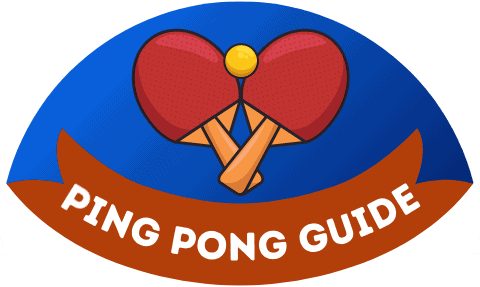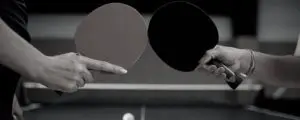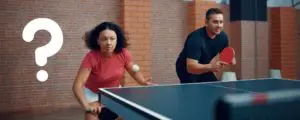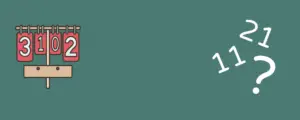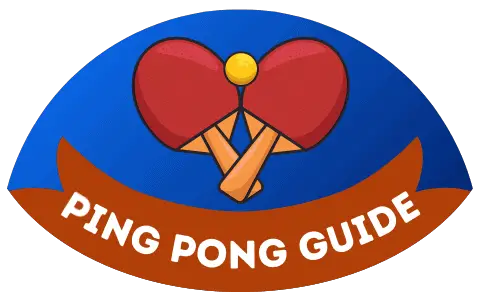Do you know this? You’re playing table tennis doubles with your friends but no one is really sure how to play it properly – “Who serves now and who receives?”. Especially in recreational play, there are always disagreements. This post is meant to explain the rules of table tennis doubles in a simple and quick way to prevent this situation.
The most important rules in a nutshell:
- The serve has to be diagonally from the right side
- The serve changes after 2 points.
- The next receiver is always the partner of the player who just served.
- The next server is the player who just was the receiver.
- During the rally, the players play the ball alternately (otherwise: point for the opponent).
Of course, there is more to doubles than just these 3 points. You will find more details following up in this post. Here is an article overview in case you are looking for something specific:
Singles vs. doubles: what’s different?
Basically, the two modes differ in only a few things. In the end, of course, it’s still the same game. However, there are a few peculiarities in doubles, which I will discuss further.
- Serving: Because of the additional people in the team, the question arises in doubles: who serves and on whom in the opposing team?
- Servingorder: There is a fixed order in which the rallies have to be played, otherwise it counts as a fault.
Let’s start with the serve…
Serving rules for doubles (execution + order)
In doubles, there are a bit more rules for the serve than in singles. Let’s look at the specifics in order:
Who starts?
In an official match, a lot (e.g. coin toss) decides which team gets to serve first. The winning team may then decide who serves first or on which side of the table they want to play first. The opposing team then gets to decide the other thing accordingly.
Which player serves and which player returns?
After deciding which team will serve first and which will receive, teams can decide for themselves which of the two players will start.
In each new set, the right of first serve changes, and the server can be chosen anew by the respective team. But more about that later…
Who starts – Example:
- Team 1 wins the coin toss and chooses to serve first. Team 2 then gets to choose the side. Team 1 determines that Player A will serve first, Team 2 chooses Player C to receive.
- Team 1 wins the coin toss and chooses the side of the board they want to play first. Team 2 then gets to choose which team will start serving. Team 2 determines that player D will serve first, and team 1 chooses player B to receive.
Serving in doubles – this is how it works (execution)
The concrete execution differs Serving rules in doubles compared to singles in exactly one thing.
The serve may only be executed diagonally from the right side. The center line separates the two sides, and the line itself belongs to the right side.
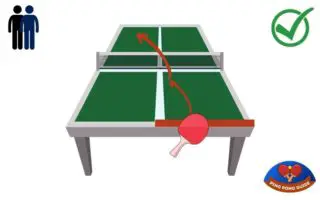
If a ball is not served diagonally during doubles, it is a fault and the opposing team gets a point.
Otherwise, as in singles, the ball must first touch the team’s own side of the table and then the opponent’s. If the ball touches the net during an otherwise correct serve, the serve is repeated. This is called a let. The serve changes after every 2 points, and in the case of extra sets (10:10) after every point.
Besides the execution of the serve, the special thing about doubles is the order of serving and receiving.
Serving order – who serves and who receives?
This is a point where disagreements often arise. The order is already determined from the beginning with the choice of the first serve and return. During the game, however, it is easy to forget “whose turn it really is”. Therefore, here is a rule of thumb:
- The last player to receive is the next server
- The partner of the last player to serve is the next receiver
Here is an example to explain this even more clearly:
Example of serving order
Situation:
- Team 1 starts and chooses player A as the server
- Team 2 chooses player C as the receiver
1. Serve Team 1: Player A on C
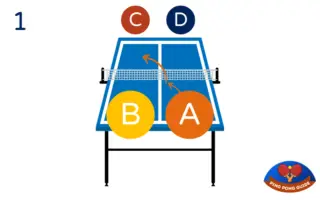
2. Serve Team 2: Player C on B
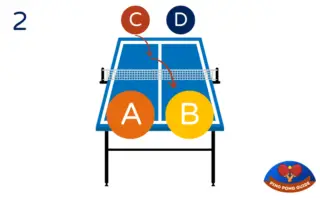
3. Serve Team 1: player B on D
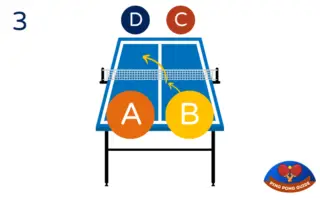
4. Serve Team 2: player D on A
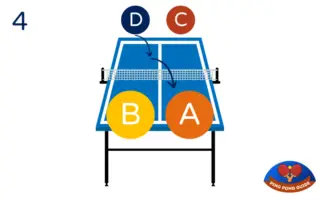
After each player has served once (i.e. after 8 points have been played), the order starts again from the beginning. So per set, you always serve on the same player. In the next set, the order changes.
Change of Sides – New Set
The right of serve changes after each set. This means that the team that was on the receiving end first in the last set now has to serve. The team can choose again which of the players serves first.
For the order to change with each set, the player who served the now serving player in the previous set is the receiver. Sounds complicated? No problem! Here is an example:
Example
The previous set was started with this order:
Team 1 had serve. Player A to player C

Now in the new set, the serve changes. That is:
Team 2 has serve. Team 2 chooses player C to serve. Since player A served C in the previous set, player A is now the first receiver.
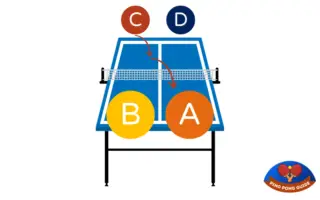
Then it goes on again in order…
Exceptions – Serve
Of course, there must be exceptions. These concern respectively the decisive situations in the set and in the match:
- Set overtime: If the score is 10:10 in a set, the serve changes, as in singles, after each point played. However, the order of service remains the same, but each player serves only one time.
- Deciding set: In the deciding set (either the 5th or the 7th), the order is changed once. As soon as one of the teams has scored 5 points, the team that is currently receiving switches the players.
During the Rally – The Order of Play
Unlike in tennis, the players in table tennis doubles always take turns hitting the ball. Due to the order of serving just explained, this naturally also results in the respective order for the rally.
Note: You only play every 4th ball yourself.
If a team does not keep to this order, it is a mistake and the opposing team gets a point.
In doubles, it is therefore extremely important to move well in order not to get in the way of your doubles partner. On the one hand, you have to position yourself as well as possible for the next ball.
Order of Play – Example
How to play doubles correctly is best learned from the pros. Therefore here is a little highlight video:
Exception
If one of the players of a team is sitting in a wheelchair due to a physical impairment, this team is exempt from the binding to the order of play during the rallies.
This means that after the serving and receiving players play the ball in the given order the team can act as they wish.
Scoring in table tennis doubles
The scoring method in doubles is the same as in singles:
- Set: The team that scores 11 points first wins the set. Since a set must always be decided with at least a 2-point lead, the score goes from 10:10 to 12, and so on
- Match: The team that first wins 3 or 4 sets (depending on the competition) wins the match
After each set played, the teams switch sides. In the deciding set, the teams additionally switch sides once, as soon as one of the teams has scored 5 points.
Questions and answers about doubles
I hope I could explain everything important about the rules of doubles, but now I would like to specifically address some frequently asked questions in this context.
Is it a mistake if the wrong player serves or receives?
As you have seen above, it is not so easy to keep the order of server and receiver. What actually happens if you play in the wrong order?
If you find that you are playing in the wrong order, you interrupt the point and then continue the game in the correct order. Playing in the wrong order in itself is not considered a fault. Therefore, if one team is in the right order and one is in the wrong order, the team in the right order does not get a point.
Furthermore, all points that were played in the wrong order remain. So points will not be deducted and redistributed retrospectively.
What if the wrong player plays the ball during the rally?
This counts as a fault and leads to a point for the opponent.
In doubles, the doubles partners always play the ball alternately. This means that you may only touch every 4th ball. If you do not keep to this order, it is a fault.
Is the center line out of bounce when serve?
According to the rules, the center line counts to the right side of the table. This means that when serving, it is in accordance with the rules when the ball hits the center line. The serve itself must always be executed from the right and diagonally.
It is therefore also in accordance with the rules if the ball hits the center line on both sides.
Is it a fault if the ball first touches the net on serve and then goes to the wrong side?
Yes, in this case, the serve is not in accordance with the rules.
A re-serve (let) is only given if the ball touches the net during an otherwise compliant serve. Since the ball is not in conformity with the rules in this case (not diagonal), the serve is a fault.
Do I have to serve with the forehand in doubles?
No, there is no rule about this.
I have included this question because I have heard this more often now. Of course, there is no rule about how exactly you have to serve.
So now I hope I could answer all your questions 😊 At this point, there is nothing else to do but to wish you a lot of fun for the next doubles match!
Enjoy the game 🏓
